Exergy and Irreversibility Analysis in Non-Equilibrium Thermal Porous Rectangular Channel
Abstract
:1. Introduction
2. Formulation of the Problem
2.1. Description of the System
2.2. Mathematical Formulation and Governing Equations
2.3. Thermodynamic Transport Properties
2.3.1. Entropy Generation
2.3.2. Bejan Number
2.3.3. Irreversibility
2.3.4. Exergy
3. Validation
4. Results and Discussion
4.1. Flow Characteristics
4.2. Thermodynamic Analysis
5. Conclusions
- Thermal equilibrium between the fluid and solid phases is achieved at low Reynolds numbers and high Biot numbers, while the Darcy number has a negligible influence on thermal equilibrium.
- Irreversibilities are predominantly caused by heat transfer, except at low Darcy numbers and high Reynolds numbers, where entropy generation due to viscous dissipation becomes significant.
- For all investigated parameters, irreversibilities contribute to exergy destruction within the system.
- Finally, thermal non-equilibrium (LTNE intensity) plays a crucial role in entropy generation, leading to substantial exergy destruction.
Author Contributions
Funding
Data Availability Statement
Conflicts of Interest
Abbreviations
| LTNE | Local Thermal Non-Equilibrium | |
| LTE | Local Thermal Equilibrium | |
| Nomenclature | ||
| Aspect ratio of the channel | [-] | |
| Bejan number | [-] | |
| Biot number | [-] | |
| Darcy number | [-] | |
| Eckert number | [-] | |
| Height of the channel | [m] | |
| Enthalpy | [J/kg] | |
| Irreversibility | [W/m3] | |
| Thermal conductivity | [W/mK] | |
| Permeability | [m2] | |
| Length of the channel | [m] | |
| Prandtl number | [-] | |
| Reynolds number | [-] | |
| volumetric entropy generation | [W/m3K] | |
| Dimensionless volumetric entropy generation | [-] | |
| Dimensionless entropy generation rate due to heat transfer | [-] | |
| Dimensionless entropy generation rate due to fluid friction | [-] | |
| Bulk temperature | [K] | |
| X component of dimensionless velocity | [-] | |
| Y component of dimensionless velocity | [-] | |
| LTNE intensity | [-] | |
| Dimensionless entropy generation | [-] | |
| Dimensionless exergy | [-] | |
| Density | [kg/m3] | |
| Dynamic viscosity, | [kg/m.s] | |
| Dimensionless temperature | [-] | |
| Porosity | [-] | |
| Conductivity ratio | [-] |
References
- Ghedira, A.; Lataoui, Z.; Benselama, A.M.; Bertin, Y.; Jemni, A. Simulation of Transpiration Cooling with Phase Change Process in Porous Media. Fluids 2025, 10, 52. [Google Scholar] [CrossRef]
- Dmitriev, S.; Sobornov, A.; Kurkin, A. Features of Motion and Heat Transfer of Swirling Flows in Channels of Complex Geometry. Fluids 2024, 9, 293. [Google Scholar] [CrossRef]
- Doucette, A.; Holagh, S.G.; Ahmed, W.H. Experimental evaluation of airlift pumps’ thermal and mass transfer capabilities. Exp. Therm. Fluid. Sci. 2024, 154, 111174. [Google Scholar] [CrossRef]
- Zaw, M.M.; Zhu, L.; Ma, R. Numerical Study of Heat Transfer Enhancement Using Nano-Encapsulated Phase Change (NPC) Slurries in Wavy Microchannels. Fluids 2024, 9, 236. [Google Scholar] [CrossRef]
- Wakata, Y.; Chao, X.; Sun, C.; Diddens, C. Evaporation of acoustically levitated bicomponent droplets: Mass and heat transfer characteristics. J. Fluid. Mech. 2024, 984, A17. [Google Scholar] [CrossRef]
- Gibis, T.; Sciacovelli, L.; Kloker, M.; Wenzel, C. Heat-transfer effects in compressible turbulent boundary layers—A regime diagram. J. Fluid. Mech. 2024, 995, A14. [Google Scholar] [CrossRef]
- Bejan, A. Entropy Generation Through Heat and Fluid Flow. J. Appl. Mech. 1983, 50, 475. Available online: https://www.academia.edu/47621841/Entropy_Generation_Through_Heat_and_Fluid_Flow (accessed on 6 February 2025). [CrossRef]
- Bejan, A. Method of entropy generation minimization, or modeling and optimization based on combined heat transfer and thermodynamics. Rev. Générale Therm. 1996, 35, 637–646. [Google Scholar] [CrossRef]
- Yang, X.; Shao, Q.; Hoteit, H.; Carrera, J.; Younes, A.; Fahs, M. Three-dimensional natural convection, entropy generation and mixing in heterogeneous porous medium. Adv. Water Resour. 2021, 155, 103992. [Google Scholar] [CrossRef]
- Onsager, L. Reciprocal relations in irreversible processes. I. Phys. Rev. 1931, 37, 405. [Google Scholar] [CrossRef]
- Keenan, J.H. Availability and Irreversibility in Thermodynamics. Br. J. Appl. Phys. 1951, 2, 183. [Google Scholar] [CrossRef]
- Glansdorff, P.; Nicolis, G.; Prigogine, I. The Thermodynamic Stability Theory of Non-Equilibrium States (thermodynamics/chemical kinetics). Proc. Natl. Acad. Sci. USA 1974, 71, 197–199. [Google Scholar] [CrossRef] [PubMed]
- Gouy. Sur l’énergie utilisable. J. Phys. Théorique Appliquée 1889, 8, 501–518. [Google Scholar] [CrossRef]
- Aurel, S. Steam Turbines: With an Appendix on Gas Turbines and the Future of Head Engines; D. Van Nostrand Co.: New York, NY, USA, 1905. [Google Scholar]
- Kaviany, M. Laminar flow through a porous channel bounded by isothermal parallel plates. Int. J. Heat Mass Transf. 1985, 28, 851–858. [Google Scholar] [CrossRef]
- Kuznetsov, A.V. Thermal Nonequilibrium Forced Convection in Porous Media. Transp. Phenom. Porous Media 1998, 1, 103–129. [Google Scholar] [CrossRef]
- Vafai, K.; Thiyagaraja, R. Analysis of flow and heat transfer at the interface region of a porous medium. Int. J. Heat Mass Transf. 1987, 30, 1391–1405. [Google Scholar] [CrossRef]
- Sahimi, M.; Hughes, B.D.; Scriven, L.E.; Davis, H.T. Dispersion in flow through porous media—I. One-phase flow. Chem. Eng. Sci. 1986, 41, 2103–2122. [Google Scholar] [CrossRef]
- Zhang, P.; Guo, B. Factors affecting the fluid temperature of geothermal energy wells converted from abandoned oil and gas wells. Adv. Geo-Energy Res. 2023, 9, 5–12. [Google Scholar] [CrossRef]
- Kaviany, M. Principles of Heat Transfer in Porous Media; Springer Nature: Dordrecht, The Netherlands, 1995. [Google Scholar] [CrossRef]
- Morosuk, T.V. Entropy generation in conduits filled with porous medium totally and partially. Int. J. Heat Mass Transf. 2005, 48, 2548–2560. [Google Scholar] [CrossRef]
- Mahmud, S.; Andrew Fraser, R. Flow, thermal, and entropy generation characteristics inside a porous channel with viscous dissipation. Int. J. Therm. Sci. 2005, 44, 21–32. [Google Scholar] [CrossRef]
- Hooman, K.; Ejlali, A. Second law analysis of laminar flow in a channel filled with saturated porous media: A numerical solution. Entropy 2005, 7, 300–307. [Google Scholar] [CrossRef]
- Hooman, K.; Hooman, F.; Mohebpour, S.R. Entropy generation for forced convection in a porous channel with isoflux or isothermal walls. Int. J. Exergy 2008, 5, 78. [Google Scholar] [CrossRef]
- Hooman, K.; Gurgenci, H.; Merrikh, A.A. Heat transfer and entropy generation optimization of forced convection in porous-saturated ducts of rectangular cross-section. Int. J. Heat Mass Transf. 2007, 50, 2051–2059. [Google Scholar] [CrossRef]
- Ahmed, A. Teach Second Law of Thermodynamics via Analysis of Flow through Packed Beds and Consolidated Porous Media. Fluids 2019, 4, 116. [Google Scholar] [CrossRef]
- Hooman, K. Entropy-Energy Analysis of Forced Convection in a Porous-Saturated Circular Tube Considering Temperature-Dependent Viscosity Effects. Int. J. Exergy 2006, 3, 436–451. [Google Scholar] [CrossRef]
- Hooman, K.; Ejlali, A. Entropy generation for forced convection in a porous saturated circular tube with uniform wall temperature. Int. Commun. Heat Mass Transf. 2007, 34, 408–419. [Google Scholar] [CrossRef]
- Chauhan, D.S.; Kumar, V. Effects of slip conditions on forced convection and entropy generation in a circular channel occupied by a highly porous medium: Darcy extended Brinkman-Forchheimer model. Turk. J. Eng. Environ. Sci. 2009, 33, 91–104. [Google Scholar] [CrossRef]
- Ko, T.H.; Ting, K. Entropy generation and optimal analysis for laminar forced convection in curved rectangular ducts: A numerical study. Int. J. Therm. Sci. 2006, 45, 138–150. [Google Scholar] [CrossRef]
- Ko, T.H. Numerical investigation on laminar forced convection and entropy generation in a curved rectangular duct with longitudinal ribs mounted on heated wall. Int. J. Therm. Sci. 2006, 45, 390–404. [Google Scholar] [CrossRef]
- Ko, T.H.; Wu, C.P. A numerical study on entropy generation induced by turbulent forced convection in curved rectangular ducts with various aspect ratios. Int. Commun. Heat. Mass. Transf. 2009, 36, 25–31. [Google Scholar] [CrossRef]
- Wu, S.Y.; Li, Y.R.; Chen, Y.; Xiao, L. Exergy transfer characteristics of forced convective heat transfer through a duct with constant wall temperature. Energy 2007, 32, 2385–2395. [Google Scholar] [CrossRef]
- Wu, S.Y.; Chen, Y.; Li, Y.R.; Zeng, D.L. Exergy transfer characteristics of forced convective heat transfer through a duct with constant wall heat flux. Energy 2007, 32, 686–696. [Google Scholar] [CrossRef]
- Yessad, B.; Souidi, F. Exergy of Laminar Flow in Porous Medium. In Exergy for a Better Environment and Improved Sustainability 1. Green Energy and Technology; Springer: Cham, Switzerland, 2018; pp. 1249–1258. [Google Scholar] [CrossRef]
- Vafai, K.; Sozen, M. Analysis of Energy and Momentum Transport for Fluid Flow Through a Porous Bed. J. Heat. Transf. 1990, 112, 690–699. [Google Scholar] [CrossRef]
- Torabi, M.; Zhang, K.; Yang, G.; Wang, J.; Wu, P. Heat transfer and entropy generation analyses in a channel partially filled with porous media using local thermal non-equilibrium model. Energy 2015, 82, 922–938. [Google Scholar] [CrossRef]
- Chee, Y.S.; Ting, T.W.; Hung, Y.M. Entropy generation of viscous dissipative flow in thermal non-equilibrium porous media with thermal asymmetries. Energy 2015, 89, 382–401. [Google Scholar] [CrossRef]
- Torabi, M.; Karimi, N.; Peterson, G.P.; Yee, S. Challenges and progress on the modelling of entropy generation in porous media: A review. Int. J. Heat Mass Transf. 2017, 114, 31–46. [Google Scholar] [CrossRef]
- Alazmi, B.; Vafai, K. Constant wall heat flux boundary conditions in porous media under local thermal non-equilibrium conditions. Int. J. Heat Mass Transf. 2002, 45, 3071–3087. [Google Scholar] [CrossRef]
- Vafai, K. Analytical characterization and conceptual assessment of solid and fluid temperature differentials in porous media. Int. J. Heat Mass Transf. 1999, 42, 423–435. [Google Scholar]
- Paoletti, S.; Rispoli, F.; Sciubba, E. Calculation of exergetic losses in compact heat exchanger passages. Eng. Environ. Sci. 1989, 10, 21–29. [Google Scholar]
- Kurtbaş, I.; Celik, N.; Dinçer, I. Exergy transfer in a porous rectangular channel. Energy 2010, 35, 451–460. [Google Scholar] [CrossRef]
- Patankar, S.V. Numerical Heat Transfer and Fluid Flow; CRC Press: Boca Raton, FL, USA, 2018. [Google Scholar] [CrossRef]
- Hadim, A. Forced Convection in a Porous Channel with Localized Heat Sources. J. Heat Transf. 1994, 116, 465–472. [Google Scholar] [CrossRef]
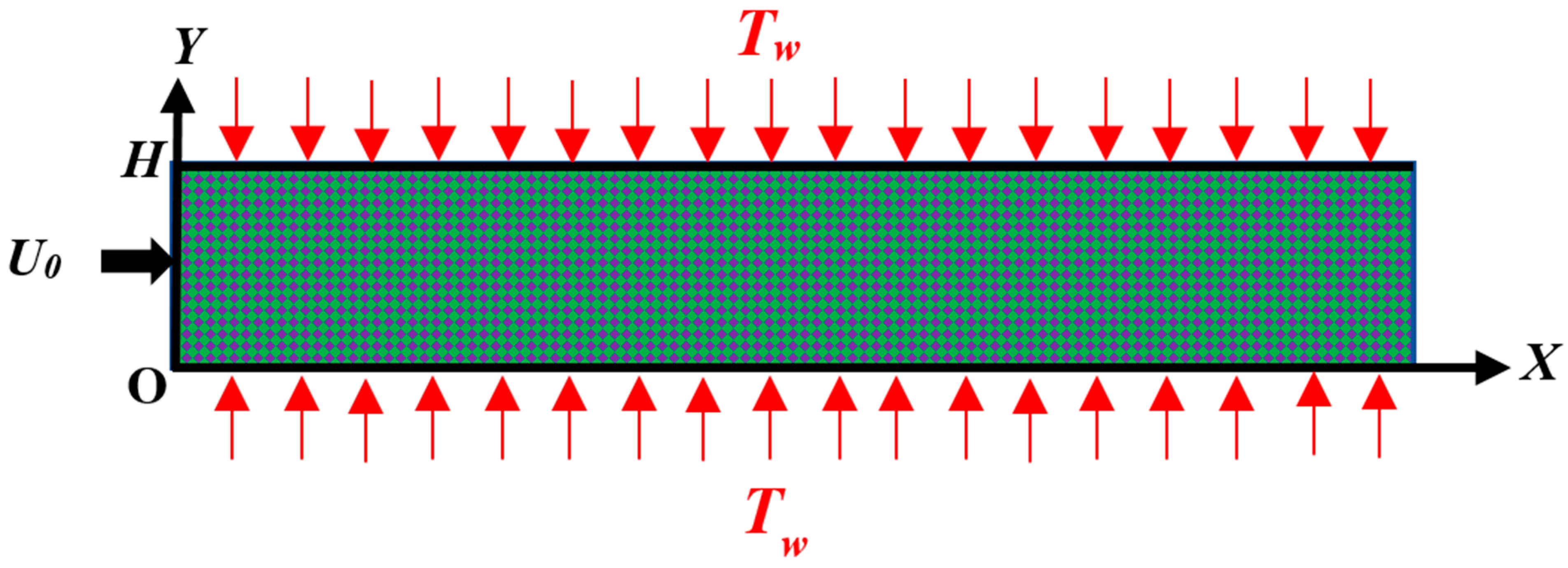


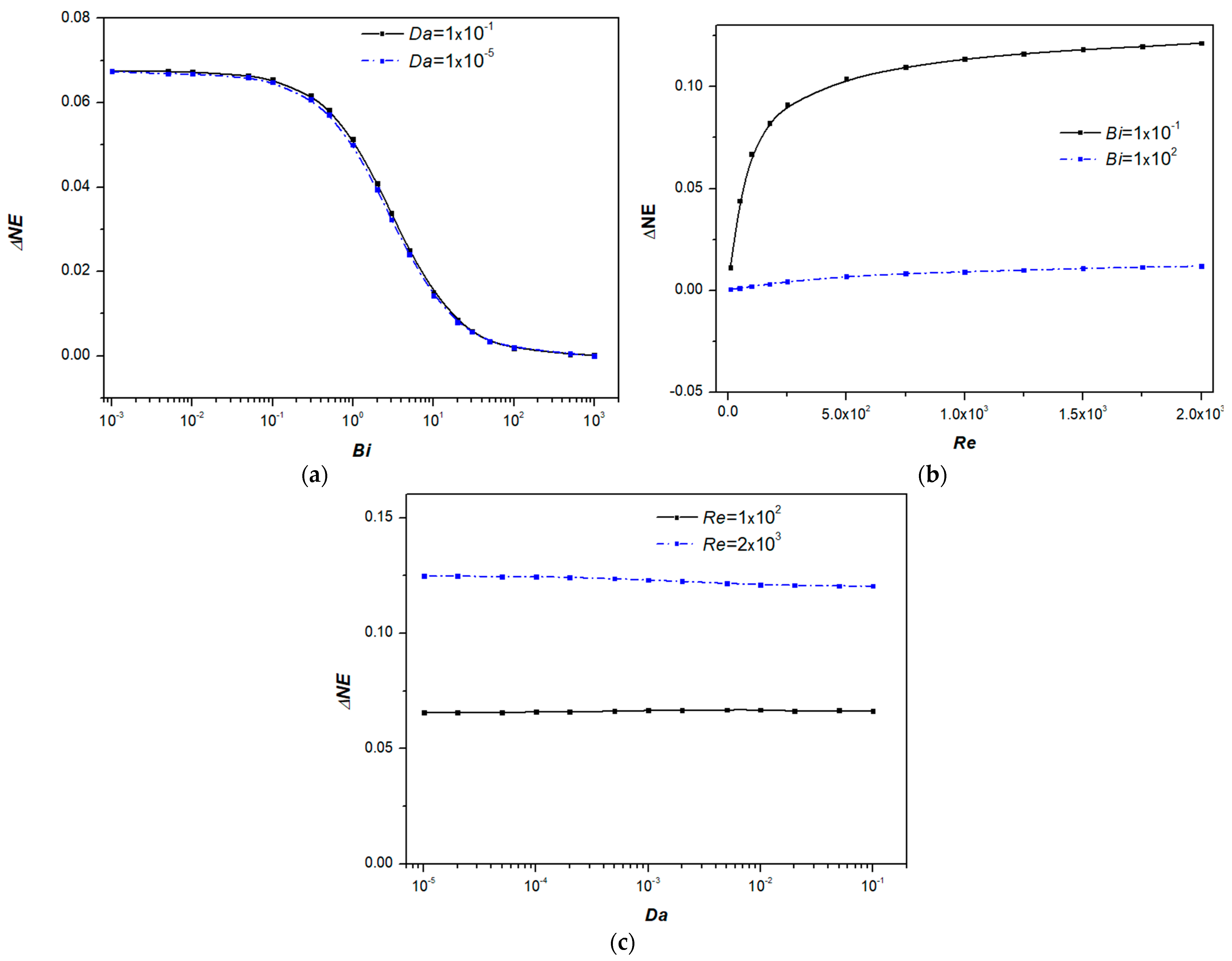
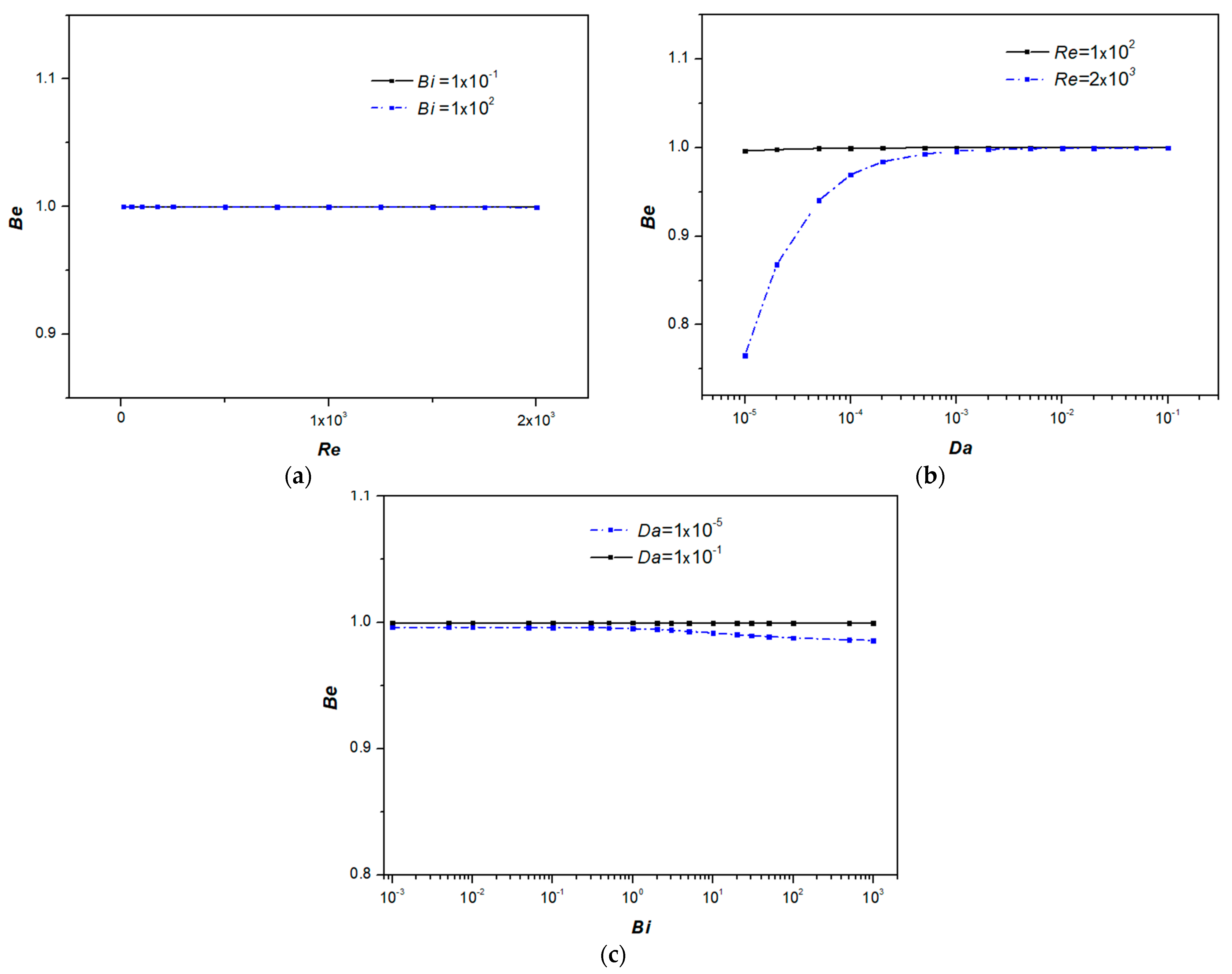
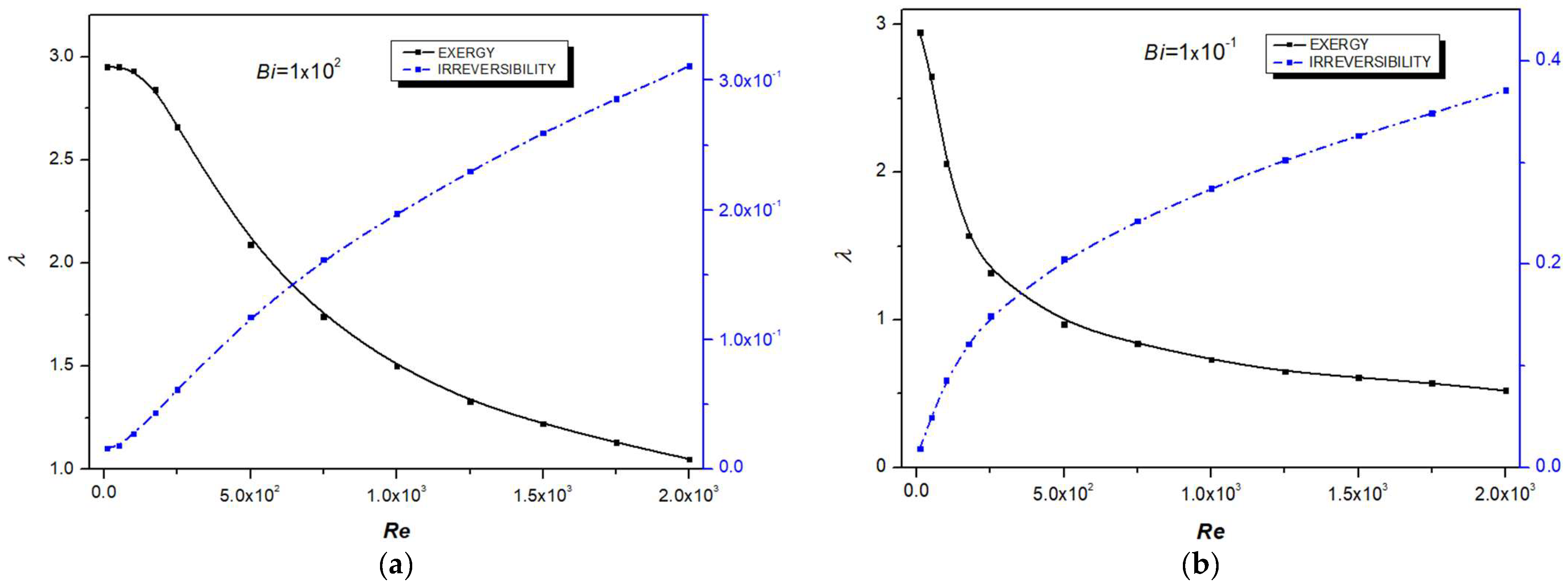
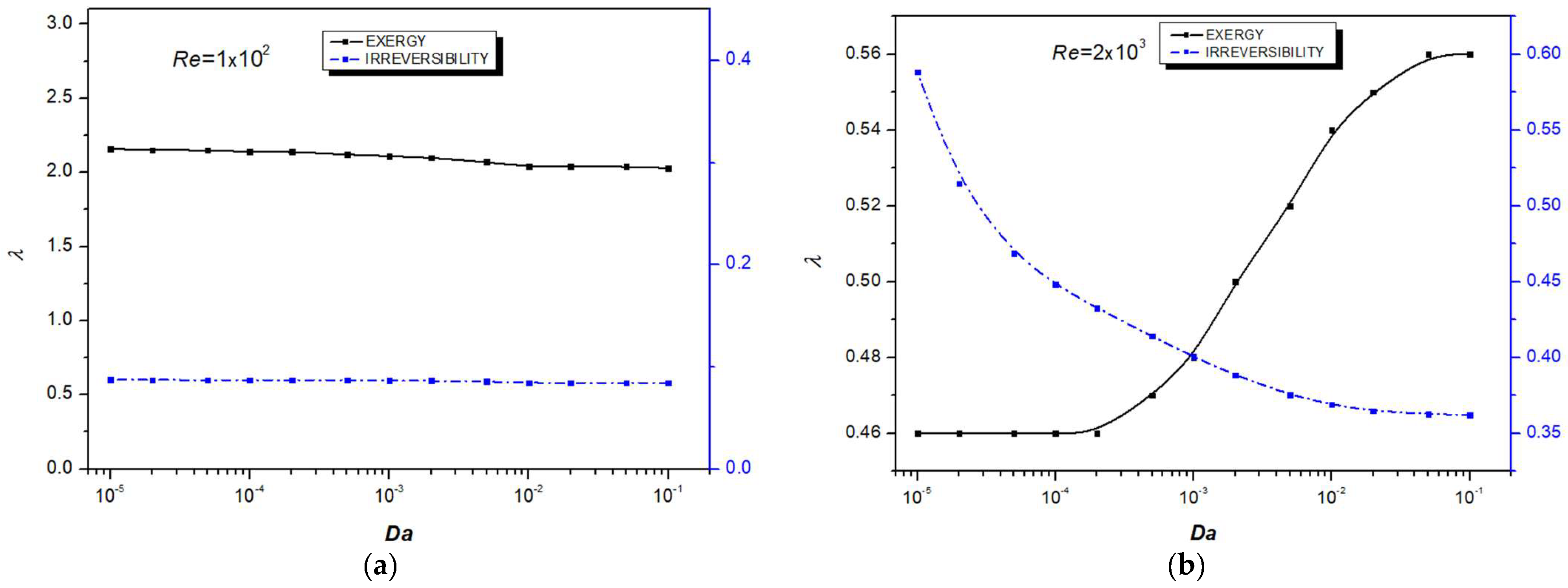
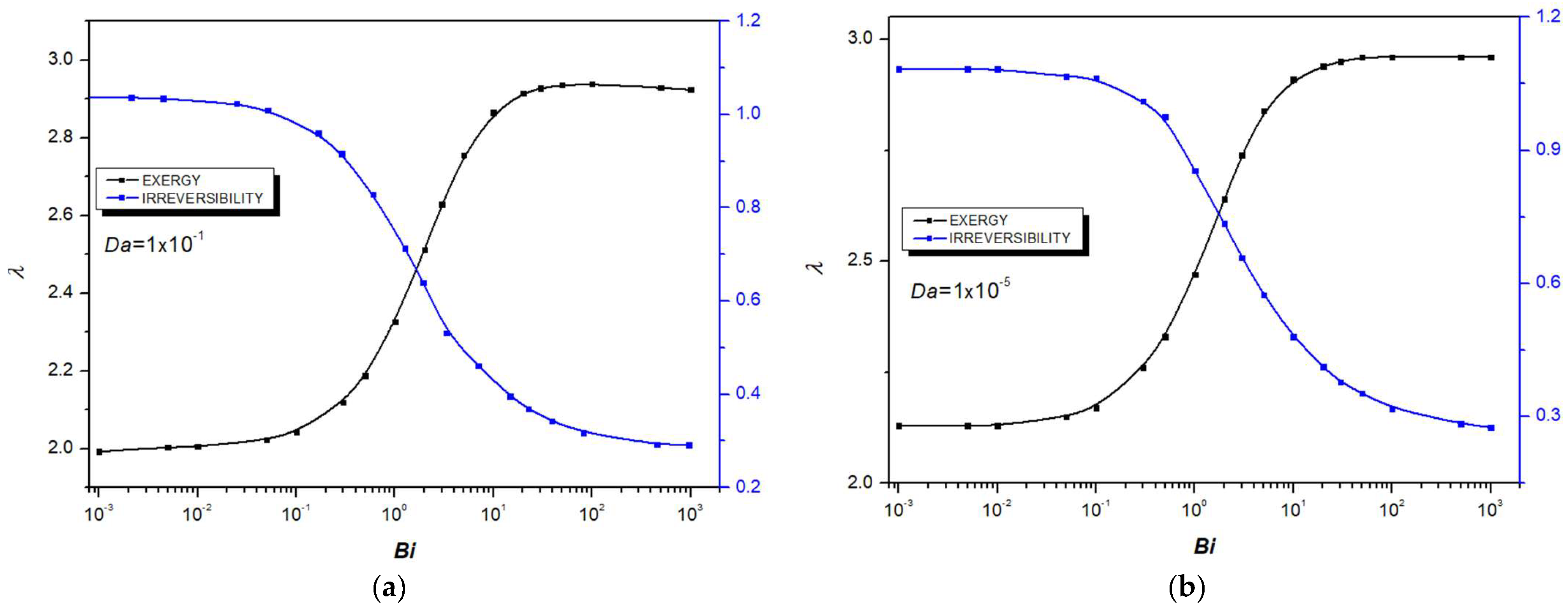
| Mesh | Grid Points | Fully Developed Center-Line Velocity | Average Nusselt Number |
|---|---|---|---|
| M1 | 0.9999 | 89.1630 | |
| M2 | 0.9999 | 93.5876 | |
| M3 | 0.9999 | 95.7540 | |
| M4 | 0.9999 | 95.7541 |
Disclaimer/Publisher’s Note: The statements, opinions and data contained in all publications are solely those of the individual author(s) and contributor(s) and not of MDPI and/or the editor(s). MDPI and/or the editor(s) disclaim responsibility for any injury to people or property resulting from any ideas, methods, instructions or products referred to in the content. |
© 2025 by the authors. Licensee MDPI, Basel, Switzerland. This article is an open access article distributed under the terms and conditions of the Creative Commons Attribution (CC BY) license (https://creativecommons.org/licenses/by/4.0/).
Share and Cite
Yessad, B.; Medelfef, A.; Arabi, A.; Souidi, F. Exergy and Irreversibility Analysis in Non-Equilibrium Thermal Porous Rectangular Channel. Fluids 2025, 10, 71. https://doi.org/10.3390/fluids10030071
Yessad B, Medelfef A, Arabi A, Souidi F. Exergy and Irreversibility Analysis in Non-Equilibrium Thermal Porous Rectangular Channel. Fluids. 2025; 10(3):71. https://doi.org/10.3390/fluids10030071
Chicago/Turabian StyleYessad, Billel, Abdessamed Medelfef, Abderraouf Arabi, and Ferhat Souidi. 2025. "Exergy and Irreversibility Analysis in Non-Equilibrium Thermal Porous Rectangular Channel" Fluids 10, no. 3: 71. https://doi.org/10.3390/fluids10030071
APA StyleYessad, B., Medelfef, A., Arabi, A., & Souidi, F. (2025). Exergy and Irreversibility Analysis in Non-Equilibrium Thermal Porous Rectangular Channel. Fluids, 10(3), 71. https://doi.org/10.3390/fluids10030071






